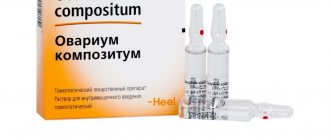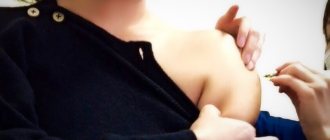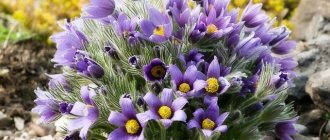Release form and composition
The drug is produced in the form of a solution for intramuscular (IM) homeopathic administration: transparent, colorless, odorless [2.2 ml in an ampoule made of colorless glass of hydrolytic class I, with a notch and a colored dot; 5 ampoules in an open plastic blister pack; in a cardboard box 1 or 20 plastic blister packs (5 or 100 ampoules.
The drug comes with instructions for use of Cutis compositum.
2.2 ml of Cutis compositum solution (1 ampoule) for intramuscular administration contains the following active ingredients (each in an amount of 0.022 ml):
- Urtica urens (Urtica) (stinging nettle) D4;
- Ledum palustre (Ledum) (marsh rosemary) D4;
- Galium aparine (tenacious bedstraw) D6;
- Strychnos ignatii (Ignatia) D6;
- Acidum phosphoricum (orthophosphoric acid) D6;
- Aesculus hippocastanum (Aesculus) (common horse chestnut) D6;
- Sanguinarinum nitricum crudum [nitric acid alkaloid sanguinarine (sanguinarine nitrate] D6;
- Arctium lappa (Arctium) (large burdock, burdock, burdock) D6;
- Cutis suis (pork skin organopreparation) D8;
- Thuja occidentalis (Thuja) (Thuja occidentalis) D8;
- Splen suis (spleen organ preparation) D10;
- Selenium (Se) (selenium) D10;
- Hepar suis (liver organ preparation) D10;
- Glandula suprarenalis suis (adrenal organ preparation) D10;
- Acidum fumaricum (fumaric acid) D10;
- Placenta fetalis suis (organic preparation of the fetal part of the placenta) D10;
- Funiculus umbilicalis suis (cow umbilical cord - umbilical cord organ preparation) D10;
- Acidum alpha-ketoglutaricum (alpha-ketoglutaric acid – Krebs cycle catalyst) D10;
- Natrium diethyloxalaceticum [Natriumdiethyloxalacetat (sodium diethyloxalacetate)] D10;
- Sulfur (S) (sulfur) D10;
- Mercurius solubilis Hahnemanni [mixture of mercuric amidonitrate, mercury and its oxide (black oxide), or mercuric dichloride, or Hahnemann's soluble mercury] D13;
- Thallium sulfuricum (thallium sulfate) D13;
- Calcium fluoratum (calcium fluoride or fluorspar) D13;
- Ichthyolum [ichthyol – ammonium bituminous sulfonate (bitumen deposits from fossil fish remains of Tyrol)] D28;
- Cortisonum aceticum (cortisone acetate) D28;
- Pyrogenium-Nosode (rotten beef - a product of septic decomposition) D198;
- Acidum formicicum (formic acid) D198.
Additional components: sodium chloride to create isotonicity; water for injections.
The relevance of using the drug Cutis compositum in the practice of a cosmetologist
Shokhirev S.A.
CJSC Arnebia, Moscow; Federal State Institution "Russian Scientific Center for Restorative Medicine and Balneology" of Roszdrav
Due to the fact that patients with age-related skin changes are the most common contingent of cosmetology institutions, it is necessary to focus on a very important factor - the elimination of wrinkles. With age, the skin is exposed to destructive factors, and irreversible changes are mainly observed in the epidermis and dermis. This is manifested by withering of the skin: wrinkles appear, elasticity decreases, the turgor and relief of the skin changes. To eliminate these problems, cosmetologists use peelings, dermabrasion and give preference to the mesotherapy method of correction. The method of intradermal administration of drugs was used back in the 18th century, when the drug was injected into painful areas. In 1950, a new doctrine was formed, called “Mesotherapy” by Michel Pistor. Mesotherapy is a technique that allows you to administer a drug to its direct destination using intradermal microinjections into the middle part of the skin (dermis). This method of exposure ensures the best distribution of the drug, and together with the application of local microtrauma (physical stimulation) creates the most favorable conditions for the activation of cellular metabolism and skin regeneration, and the prolonged effect of the drug achieved when using this technique (slowing down the flow of the substance into the bloodstream) is due to its breeding. The targeted local inflammatory response is adaptive in nature. It reflects the earliest stages and mechanisms of the inflammatory response, i.e. precisely that phase of urgent adaptation of the skin to damage, which is currently the least studied. Since the methods used are empirical in nature and formed by the most general ideas about the features of the development of the inflammatory reaction in the skin, this circumstance allows us to highlight the applied and fundamental significance of the study aimed at identifying the patterns of general and local reactions of the skin during its microdamages.
In their work “Features of the effect of the drug Cutis compositum on local components of the inflammatory reaction in the skin during mesotherapeutic administration” (experimental study), the authors E.O. Sheveleva, I.A. Komarevtseva, E.A. Orlova studied the features of the development of a local inflammatory reaction during intradermal microinjections of various drugs, and also found out the main mechanisms of response and prediction of the skin's response to such effects.
For this purpose, laboratory animals were subjected to mesodermal administration of drugs with opposite types of action - pro-inflammatory (nicotinic acid) and anti-inflammatory (Cutis compositum). For control purposes, animals that were injected with saline and intact animals were studied.
The data were confirmed by morphometric and biochemical results.
Morphometric indicators at all periods of exposure revealed the development of very “delicate” local inflammatory changes in the epidermis and dermis; however, this reactive inflammatory process had its own characteristics. After the administration of the anti-inflammatory drug Cutis compositum, there was a morphological tendency towards an increase in the vascular component; the number of collagen fibers was noticeably higher than when using nicotinic acid and saline solution. Thus, it can be noted that regeneration and restoration processes in the skin occurred more intensively when using the drug Cutis compositum, which was associated with a more intense proliferation of connective tissue and active vascularization of the dermis. With regard to biochemical parameters, it was noted that when using Cutis compositum, an increase in collagen or swelling of collagen with minor elements of edema was observed, while nicotinic acid contributed to a significant increase in the amount of epidermis, glandular infiltrate and edematous areas. The number of collagen fibers with the introduction of nicotinic acid was reduced compared to Cutis compositum and saline solution. The latter helped to conclude that when using nicotinic acid, alternative processes predominate at the initial stages of exposure, and a longer persistence of the inflammatory reaction in the skin with the phenomena of exudation and infiltration is observed.
Indicators of phagocytosis activity (oxygen burst, intensity of chemotaxis), intensity of apoptosis also prevailed in the experimental group (Cutis compositum), which contributed to the course of proliferative processes that dominated alterative ones - thickening of the epidermis, edema, infiltration. That is, more active regeneration in the skin was observed after procedures with Cutis compositum. When examining the animal's skin, an improvement in its turgor (folding of the skin) and elasticity (extensibility) was noted. There was a high positive relationship between the degree of alterative morphological manifestations and the intensity of apoptosis. Thus, the more pronounced the inflammatory reaction in the skin, the stronger the anti-inflammatory morphological and biochemical characteristics (oxygen burst activity, intensity of phagocyte chemotaxis), the more cells of the immunocompetent system are formed, which contribute to increased apoptosis of cells participating in the formation of acute inflammation. All these indicators are highly reliable. After using Cutis compositum, apoptosis in skin cells is insignificant compared to nicotinic acid, but slightly higher than in the control group, which indicates increased proliferation and activation of the regenerative functions of the skin. The complex homeopathic preparation Cutis compositum, in addition to suis-organ components, also contains agents that regulate reparative processes in the skin (selenium, ichthyol), significantly improves the condition of the skin according to morphometry, DNA fragmentation of skin cells and phagocytic activity of neutrophils. This circumstance helps us to conclude that improving the aesthetic properties of the skin becomes effective after using the drug Cutis compositum, which can be recommended to patients as anti-aging procedures.
Mesotherapy is a justified method of treating age-related skin changes, because... allows you to easily penetrate the inner layers of the skin and deliver directly into the extracellular tissue substance the drugs necessary to activate the metabolic processes of aging tissue. According to experimental studies conducted on the effect of the drug Cutis compositum and based on the results and recommendations obtained, we carried out therapeutic mesotherapy procedures to rejuvenate the skin of the face and neck of 27 patients. Mesotherapy was carried out only with the drug Cutis compositum. The procedures were performed in cosmetology clinics and offices. The age of the patients is from 35 to 55 years.
I. Before starting mesotherapy treatment, all rules for receiving patients were observed:
1. Taking an anamnesis.
2. Indications and contraindications for the procedure are determined; full information is provided about what mesotherapy is, what results should be expected and when, what side effects and complications may be.
3. Mandatory documents have been completed: medical record, agreement to perform the procedure and agreement between the patient and the medical center.
4. The treatment plan, the choice of drugs, and equipment have been determined.
5. Photographs of the patient.
II. The patient's preparation immediately before the mesotherapy session consisted of superficial peeling, cleansing and disinfection of the skin with 76% alcohol.
III. After mesotherapy, the skin was cleansed with distilled water, dried and lubricated with Traumeel S ointment, which has regenerating and anti-inflammatory properties, as well as a soothing effect to reduce erythema and swelling at the injection sites.
A mesotherapy session with the drug Cutis compositum was carried out using the micropapules technique and varieties of linear techniques (grill, herringbone technique, tunnel method). The drug was injected into small papules along wrinkles at a distance of 5-10 mm. from each other. The syringe and needle are located tangentially to the skin, the bevel of the needle is directed upward. The drug is injected into the papillary layer of the dermis to a depth of 2 mm. With the linear technique, the drug was injected in lines parallel to the angle of the lower jaw along the surface of the cheeks.
All patients received a positive effect from the use of mesotherapy procedures with the drug Cutis compositum.
After the sessions, patients of all groups noted an improvement in the general condition of the body, efficiency was restored, they became less irritable, sleep normalized, interest in current events appeared, interest in others, and self-esteem increased.
Patients of the first group saw an improvement in the skin and felt changes occurring in the body from the first mesotherapy procedure. Single wrinkles have disappeared. By the 3rd session, all patients in this group were satisfied with the effect of the drug Cutis compositum.
Patients of the second group felt and saw improvement by the 3-4 procedure. The skin acquired a flesh color, the puffiness under the eyes disappeared, small wrinkles practically disappeared, the deep ones became much smaller, by the end of the sixth session the patients noted: the skin became elastic, there were no small or large wrinkles.
Patients of the third group saw and felt improvement by the 4th procedure. They noted a change in skin color. The skin began to look fresh, the puffiness under the eyes decreased, skin turgor increased, there were fewer fine wrinkles, and deep wrinkles began to “tighten up,” especially on the face. By the 6-7th procedure, fine wrinkles are practically absent, deep wrinkles remained at the same level. By the 9th procedure, patients note that the facial skin has acquired a flesh color, has become more elastic, fine wrinkles are not observed, deep wrinkles have begun to straighten out, and swelling under the eyes has disappeared. Patients of the third group are satisfied with the result of mesotherapy with the drug Cutis compositum and note that they began to look younger.
According to experimental studies on the effect of the drug Cutis compositum and based on the results of observations of patients receiving mesotherapy treatment, it helps to conclude that improving the aesthetic properties of the skin becomes effective after using the drug Cutis compositum, which can be recommended to cosmetologists for anti-aging procedures .
Allergic reactions and side effects from the use of the drug Cutis compositum have not been recorded. ‹ Abstracts of the 1st Forum of Medicine and Beauty. M., 2008Up Allokin - alpha in the complex treatment of Zhiber pink lichen ›
Pharmacological properties
Cutis compositum is a multicomponent homeopathic medicine, the effect of which is determined by the properties of the active substances included in its composition.
Indications for use for individual components of the homeopathic remedy:
- Cutis suis: stimulation of skin function, treatment and prevention of dermatoses, seborrhea, eczema, skin cracks, bedsores, skin manifestations of allergic (neurodermatitis) and other (burns, conditions after radiation therapy) nature;
- Hepar suis: stimulating liver detoxification;
- Placenta fetalis suis: pathologies of peripheral circulation; treatment and prevention of bedsores, leg ulcers, eczema, marbled skin;
- Glandula suprarenalis suis: neurodermatitis, skin cracks, burns;
- Splen suis: stimulating the function of the spleen and the protective functions of the body;
- Funiculus umbilicalis suis: stimulation of connective tissue functions; circulatory pathologies, dermatitis, neurodermatitis;
- Thuja occidentalis: diseases of the skin and mucous membranes (especially with a tendency to neoplasms: warts, papillomas, nevi); depressed mood;
- Galium aparine: ulcers, ulcers (especially on the tongue); precancerous neoplasms and neoplasia;
- Selenium: skin rash, oily skin, digestive disorders;
- Thallium sulfuricum: alopecia (hair loss);
- Strychnos ignatii: neurotic disorders, depressed mood; skin hypersensitivity;
- Sulfur: skin diseases of various origins (especially chronic ones), itchy eczema and pustular skin diseases (primarily dirty skin with itching and unpleasant body odor); inflammation of the gastrointestinal tract; liver dysfunction; general weakness, neurotic disorders, behavioral and perception disorders; constitutional, reactionary and restructuring agent for stimulating immunity;
- Cortisonum aceticum: connective tissue diseases; dysfunction of the adrenal glands and the anterior pituitary gland;
- Urtica urens: diseases of the skin and subcutaneous tissue like urticaria - the appearance on the skin of blisters with clear boundaries (pinkish-red, itchy), varied in shape and size, raised above the skin level;
- Acidum phosphoricum: states of physical/mental exhaustion, calcium metabolism disorders;
- Calcium fluoratum: inflammation of the gastrointestinal tract; degenerative processes of connective tissue; thyroid diseases;
- Mercurius solubilis Hahnemanni: inflammation of the lymph nodes; skin diseases, exhaustion and diseases that contribute to its appearance;
- Aesculus hippocastanum: hemorrhoids, venous congestion and its consequences;
- Ichthyolum: pustular skin diseases;
- Sanguinarinum nitricum: inflammatory diseases of the respiratory system; acne;
- Ledum palustre: puncture wounds, bites, consequences of bites of various insects, for example, bees, ants, wasps, bumblebees, etc.; bleeding from mucous membranes and skin;
- Arctium lappa: skin rash complicated by weeping of the skin;
- Acidum formicicum: eczema, hypersensitivity reactions;
- Pyrogenium-Nosode: severe infections; infected wounds;
- Acidum alpha-ketoglutaricum (regulates the Krebs cycle and redox processes): non-healing purulent wounds, dermatoses, scaly eczema, mycoses, skin susceptible to disease;
- Acidum fumaricum (regulates the Krebs cycle and redox processes): acne, dermatoses, food allergies (seborrhea, including seborrheic alopecia, and eczema);
- Natrium diethyloxalaceticum: (regulates the Krebs cycle and redox processes): dermatoses (allergic and weeping eczema); hyperhidrosis.
Cutis Compositum solution d/in amp 2.2ml No. 100
Compound
Active substances:
- Cutis suis (cutis suis) D8 22 µl;
- Hepar suis (hepar suis) D10 22 µl;
- Splen suis (splen suis) D10 22 µl;
- Placenta totalis suis (placenta totalis suis) D10 22 µl;
- Glandula suprarenalis suis (glandula suprarenalis suis) D10 22 µl;
- Funiculus umbilicalis suis (funiculus umbilicalis suis) D10 22 µl;
- Thuja oссidentalis (Thuja) (Thuja occidentalis (Thuja)) D8 22 μl;
- Galium aparine (galium aparine) D6 22 µl;
- Selenium (selenium) D10 22 µl;
- Thallium sulfuricum (thalium sulfuricum) D13 22 µl;
- Stryсhnos ignatii (Ignatia) (strychnos ignatii (ignatia)) D6 22 µl;
- Sulfur D10 22 µl;
- Cortisonum aceticum (cortisonum aceticum) D28 22 µl;
- Urtica urens (Urtica) (urtica urens (urtica)) D4 22 µl;
- Acidum phosphoricum (acidum phosphoricum) D6 22 µl;
- Calcium fluoratum (calcium fluoratum) D13 22 µl;
- Mercurius solubilis Hahnemanni (Mercurius solubilis Hahnemanni) D13 22 µl;
- Aesculus hippocastanum (Aesculus) (Aesculus hippocastanum (Aesculus)) D6 22 µl;
- Ichthyolum (ichthyolum) D28 22 µl, Sanguinarinum nitricum (Sanguinarinum nitricum crudum) (sanguinarinum nitricum crudum) D6 22 µl;
- Ledum palustre (Ledum) (ledum palustre (ledum)) D4 22 µl;
- Arctium lappa (Arctium) (Arctium lappa (Arctium)) D6 22 µl;
- Acidum formicicum (formicicum acidum) D198 22 µl;
- Pyrogeniun-Nosode (pyrogenium-nosode) D198 22 µl;
- Acidum α-ketoglutaricum (acidum alpha-ketoglutaricum) D10 22 µl;
- Acidum fumaricum (acidum fumaricum) D10 22 µl;
- Natrium diethyloxalaceticum (Natriumdiethyloxalacetat) (sodium diethyloxalacetate) D10 22 µl.
Excipients: sodium chloride to establish isotonia, water for injection 1606 mg.
Indications for use
Treatment of moderate to moderate acne.
Contraindications
- Hypersensitivity to the components of the drug, especially to ichthyol.
- Age up to 18 years due to insufficient clinical data.
Directions for use and doses
The frequency and duration of administration of the drug is determined by the attending physician individually or 1 ampoule 1-3 times a week intramuscularly. The course of treatment is 4 weeks.
Storage conditions
In a place protected from light, at a temperature not exceeding 30 °C. Keep out of the reach of children!
Best before date
5 years. Do not use after the expiration date stated on the package.
special instructions
When taking homeopathic medicines, existing symptoms may temporarily worsen (primary worsening). In this case, you should stop using the drug and consult your doctor.
Description
Homeopathic remedy.
Dosage form
Colorless, transparent, odorless liquid.
Action
A multicomponent homeopathic medicine, the effect of which is determined by the components included in its composition.
Side effects
Allergic reactions and increased salivation are possible. If side effects occur, you should stop using the drug and consult a doctor.
Use during pregnancy and breastfeeding
The use of the drug is possible if the expected benefit to the mother outweighs the potential risk to the fetus and child. A doctor's consultation is required.
Interaction
The use of homeopathic medicines does not exclude treatment with other medicines.
Overdose
Cases of overdose have not been reported to date.
Impact on the ability to drive vehicles and operate machinery
The drug does not affect the performance of potentially hazardous activities that require special attention and quick reactions (driving a car and other vehicles, working with moving mechanisms, working as a dispatcher and operator, etc.).
Cutis compositum, instructions for use: method and dosage
Cutis compositum solution is administered by intramuscular injection.
The frequency and duration of treatment is determined by the doctor individually.
Standard dosage: intramuscular injections are made 1-3 times a week, 2.2 ml (contents of 1 ampoule), course – 4 weeks.
When opening the ampoule, you need to hold it so that the colored dot is at the top. The solution in the ampoule head must be shaken off by lightly tapping, then the upper part of the ampoule should be broken off by pressing on the colored dot.
Reviews of Kutis compositum
The few reviews about Cutis Compositum found on medical websites are in most cases positive. Patients note that the homeopathic remedy helps to significantly improve the appearance of their skin, namely, it relieves inflammation, reduces acne and leads to the disappearance of acne. The drug has proven itself both in the treatment of acne in adolescents and in women during menopause due to hormonal imbalances.
At the same time, there are reviews in which users indicate the absence of positive changes after a full course of treatment. Typically, this result was observed in patients who used the product independently, without consulting a doctor. Specialists, as a rule, prescribe the drug at the end of long-term complex therapy, in order to maintain previously achieved positive results.
There are no complaints about the development of adverse reactions.



